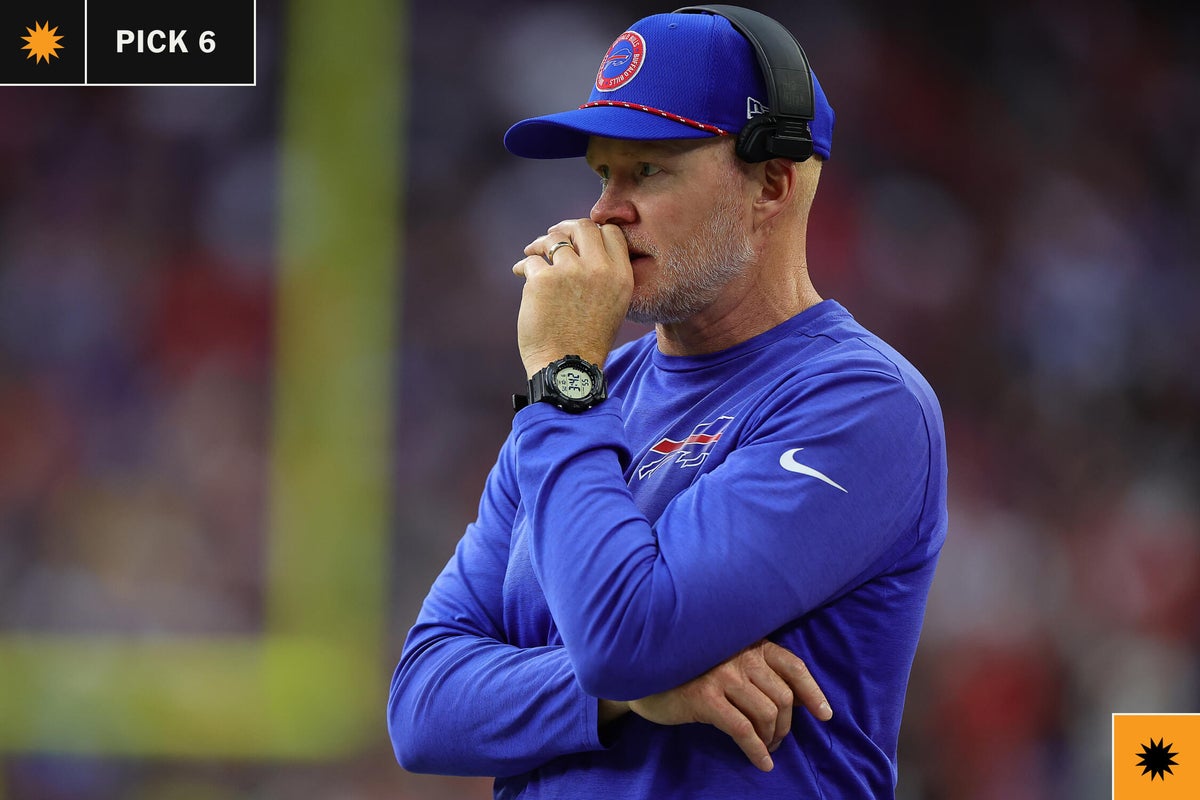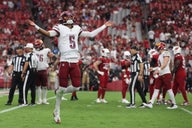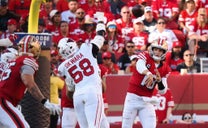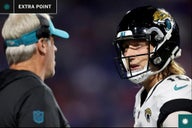
One hour passed before Buffalo Bills coach Sean McDermott appeared for his postgame news conference Sunday.
Criticism rained down on him in the meantime.
“Baffling game-management decisions by the Bills,” J.J. Watt wrote.
“There will be worse losses in the NFL this year than the one the Bills just took,” ESPN’s Mike Greenberg added. “But there may not be a dumber one.”
What was McDermott going to say when he finally emerged to face the public following Buffalo’s excruciating defeat, 23-20 at Houston?
The Pick Six column leads this week with a look at the Bills’ first crisis of this young season. We explore why the game-management critics are overreacting, what McDermott’s postgame commentary revealed (good and bad) and why Buffalo needs to consider making a move for Davante Adams by the trade deadline. The full menu:
• Breaking down Sean McDermott
• Commanders/Browns epic contrast
• Aaron Rodgers’ needed reckoning
• Vance Joseph’s D saving Broncos
• Dan Campbell’s amazing reversal
• 2-minute drill: Falcons, Jags, more
1. Let’s break down this Bills defeat and its implications from the relevant angles.
• Game management overreaction: The Bills lost in regulation despite taking over possession with 32 seconds remaining in a game tied 20-20. It seemed calamitous.
The Bills somehow lost this game in regulation pic.twitter.com/3OxHaM6o0q
— NFL on CBS 🏈 (@NFLonCBS) October 6, 2024
It was certainly painful. But it wasn’t felonious.
Houston holding all three timeouts when Buffalo took over possession was the key variable exonerating McDermott.
Yes, the Bills had quarterback Josh Allen throw deep on all three plays from Buffalo’s 2-yard line before punting, at which point Houston took over at the plus-46 with seven seconds left. Texans quarterback C.J. Stroud completed a 5-yard pass, Houston called timeout and kicker Ka’imi Fairbairn made the winning 59-yard field goal.
Crushing for Buffalo. But if the Bills had run the ball three times instead of passing, we could estimate six seconds coming off the clock for each running play, with Houston calling a timeout to stop the clock after each one. Take away another seven seconds for a punt and Houston would emerge with the same seven seconds the Texans wound up with anyway.
The Texans would have exhausted all three timeouts in the process, so they would have needed to complete a pass to the sideline instead of toward the middle of the field in setting up the winning kick. Teams do that all the time.
Houston also likely would have needed to gain more yards to get in position for the field goal, assuming Buffalo had gained some yardage on the ground. But the tradeoff for the Bills would have been depriving Allen of chances to make big plays.
Allen’s first pass, thrown 16 yards past the line of scrimmage, produced contact between the receiver and defensive back, resulting in a flag for offensive pass interference. Sometimes those go the other way. The second pass, thrown 42 yards downfield, had an outside shot at connecting. On third-and-10, Curtis Samuel was wide open over the middle 18 yards downfield and Allen saw him, but pressure forced the throw to come up short.
“If McDermott didn’t have a Tier 1 QB, he would have done an alternative approach,” a coach from another team said.
• The good from McDermott’s postgame: Anticipation built after the game as the minutes turned to an hour before McDermott finally appeared. Would a still-simmering McDermott get defensive? Would he sidestep responsibility or shift blame to others?
When McDermott emerged, he was cool, calm, collected and accountable. He said he wished he had run on first down before reassessing his strategy, but he didn’t blame offensive coordinator Joe Brady.
“Either way, we have to do a better job, and that starts with me,” McDermott said. “I love Josh with the ball in his hands. Again, efficient offense was the correct approach there, and I didn’t have us do that. So, again, you learn from that.”
To a Bills cynic, this was the latest example of Buffalo coming up on the wrong side of a critical situation — not nearly as bad as botching the final 13 seconds at Kansas City in the playoffs after the 2021 season, but notable enough to include somewhere down the list. My point is simply that McDermott could have been uptight and defiant, but was not, and that was welcome.
• The less good from McDermott’s postgame: While it’s refreshing to hear him say lessons can be learned, rather than pushing back, McDermott did hand over defensive play-calling duties to Bobby Babich this season, which means he should have a clear strategy for handling these situations. If McDermott wanted shorter passes thrown or wanted to run the ball on first down, that should be spelled out in advance.
In his defense, however, this particular situation was exceedingly rare. This was only the second time since 2000, per TruMedia, that a team took possession inside its own 5-yard line with 1:00 to 0:30 remaining in regulation, the score tied and the defensive team holding all three timeouts.
• Why Davante Adams: At the trading deadline one year ago, I contended that the Bills needed McDermott to show he had another gear more than they needed a player from another team, because the intensity he brought to seemingly every situation kept his team in a perpetual state of chaos at the most critical times.
With Allen completing 9 of 30 passes against the Texans for the lowest single-game completion rate of his career, and with the Bills having now lost ugly to AFC contenders in successive weeks, acquiring Adams could add firepower on the field and some needed adrenaline in the locker room. The Bills need to do something to help Allen, or he’ll struggle to make it through the season.

GO DEEPER
Russini’s what I’m hearing: Davante Adams trade race, why Cowboys are out, Adams’ worries about Jets
Adams could give the Bills what they lost in the Stefon Diggs trade without bringing back the history and baggage.
2. The contrast between the Washington Commanders and Cleveland Browns could not be clearer.
Washington’s 34-13 blowout over Cleveland showcased two extremes on the karma continuum.
The Commanders’ marriage between offensive coordinator Kliff Kingsbury and quarterback Jayden Daniels appears carefully planned, almost fated. It’s been a perfect pairing to maximize production right away. Daniels leads the league in EPA per pass play for an offense averaging 31 points per game. The Washington franchise is reborn and filled with hope.

GO DEEPER
Jayden Daniels and the Commanders’ offense have been even better than you think
The Browns’ marriage between coach Kevin Stefanski, new offensive coordinator Ken Dorsey and quarterback Deshaun Watson feels forced, awkward and increasingly hopeless. Watson ranks 31st in EPA per pass play for an offense averaging 14.2 points per game. Cleveland feels stuck.
“Problem is, what do they do to spark the team?” an exec from another team said. “Their hands are tied.”
Watson’s contract makes it so, for now.
“We’re not changing quarterbacks,” Stefanski said.
Watson’s EPA per pass play ranks 618th out of 621 quarterbacks who started the first five games of a season since 2000. The table below shows where all qualifying Browns quarterbacks rank among the 621. Brian Hoyer never knew how much he’d be missed. (Not pictured, 2023 Browns alum Joe Flacco, who now has five touchdown passes, no interceptions and a 115.6 passer rating for Indianapolis.)
Browns QBs, Games 1-5: 2000-24
| NFL Rank | QB | Season | EPA/Pass Play |
|---|---|---|---|
|
64 |
Brian Hoyer |
2014 |
+0.265 |
|
251 |
Baker Mayfield |
2021 |
+0.102 |
|
264 |
Baker Mayfield |
2020 |
+0.099 |
|
314 |
Jacoby Brissett |
2022 |
+0.072 |
|
412 |
Colt McCoy |
2011 |
+0.014 |
|
418 |
Derek Anderson |
2008 |
+0.011 |
|
427 |
Tim Couch |
2001 |
+0.003 |
|
433 |
Tim Couch |
2000 |
-0.002 |
|
457 |
Trent Dilfer |
2005 |
-0.018 |
|
481 |
Jeff Garcia |
2004 |
-0.034 |
|
525 |
Charlie Frye |
2006 |
-0.066 |
|
537 |
Brandon Weeden |
2012 |
-0.076 |
|
599 |
Baker Mayfield |
2019 |
-0.186 |
|
601 |
DeShone Kizer |
2017 |
-0.188 |
|
618 |
Deshaun Watson |
2024 |
-0.302 |
For years, Stefanski fielded run-oriented offenses shielding quarterback exposure to difficult situations. From 2018 through 2023, his offenses in Minnesota and Cleveland passed 51 percent of the time on early downs in the first 28 minutes of games, before time and score differential exert more influence on play calling. The Browns’ rate is 63 percent this season, good for a No. 3 ranking on the Cook Index through five games.
“It’s like they want to be Kansas City and they are just forcing it,” a defensive coordinator from another team said.
Cleveland has been heading this way with Watson in the lineup. The pass rate in these situations was 46 percent with Watson in the lineup for six games in 2022 and 53 percent for the six games he started last season.
From afar, it feels as though the Browns are making an organizational decision to open up their offense with Watson to justify the $230 million they committed to him.
“You were trying to protect Joe Flacco by handing it off last year,” an offensive coach from another team said. “With this quarterback (Watson), you can do whatever you want, supposedly, so you try to, but it’s not in your DNA. It’s cool if it is working, but if it is not working, guys are standing around looking at each other saying, ‘Wait a minute, why are we doing this?’”
Running back Nick Chubb’s absence is part of the equation. Cleveland also added Dorsey, the former Bills coordinator who enjoyed success in Buffalo but also leaned toward the pass (Buffalo has become more run-oriented since his departure). The Browns, whose offensive line has been battered by injuries for the second consecutive year, also lost acclaimed line coach Bill Callahan to Tennessee. His voice could have been a strong one.
“I don’t know what they are doing,” another exec said. “No identity. Maybe it is Chubb not being there. They cannot help but have taken a step back without Callahan. It doesn’t seem like this is Stefanski’s offense.”
Chubb returned to practice this week as he recovers from a serious knee injury. We’ll see if anything changes once he’s back in the lineup.
3. It could be time for a 40-year-old Aaron Rodgers reckoning.
With three interceptions and four sacks Sunday, Jets quarterback Aaron Rodgers suffered through one of his worst career starts.
Rodgers’ EPA per pass play (-0.38) during the 23-17 defeat to the Minnesota Vikings was his ninth-worst in 247 regular-season and postseason starts when he attempted at least five passes. His performance in a 10-9 defeat to Denver last week produced his 13th-worst EPA-per-pass-play game.
For years, Rodgers’ incomplete passes have been as impressive as some quarterbacks’ completed ones. That’s been true much this season and was true at times Sunday, but Rodgers’ age-related limitations are also clear.
“He looked great against New England a couple weeks ago, but he’s banged up and at 40 can’t accelerate through the B-gap the way he used to,” a coach who watched the Jets play Sunday said.
Rodgers has taken 13 sacks this season, which is not close to his career high through five games (he has taken 25, 21 and 19 sacks through five games previously, but he also could elude the rush to make big plays then).
“You know the slide and then take two steps and then he kicks out of that every time in Green Bay?” the coach added. “He slides, takes two steps and gets sacked now. He has to look at the film and be honest with himself and say, ‘I’m banged up, not moving that quickly anymore, so throw it away. More 55-60 percent (completion rate) games, not 70.”
The chart above is an updated version of the one we published last week. The Jets’ offense has become as statistically bad as it was before Rodgers arrived.
4. Former Broncos coach Vance Joseph is doing a solid for current Broncos coach Sean Payton.
It’s been a good run over the 379 days since Denver allowed 726 yards to the Miami Dolphins in a 70-20 defeat that any defensive coordinator would have a difficult time living down.
• Where the Joseph-coordinated Broncos defense ranked in EPA per play through four games last season: last in the 32-team league, and 798th out of 798 teams since 2000 when looking only at the first four games of all seasons.
• Where the Joseph-coordinated Broncos defense ranks in EPA per play since then: fourth out of 32 teams, which is the leading reason, by far, that Denver has a winning record (11-8) over that span, including 3-2 in 2024.
The Broncos rank 27th in offensive EPA per play since the blowout defeat at Miami, including 30th this season. The defense is letting them survive while playing rookie quarterback Bo Nix before Nix appears ready.
Pat Surtain II’s interception and 100-yard touchdown return off Gardner Minshew in the Broncos’ 34-18 victory over the Las Vegas Raiders produced the largest single-play EPA change in the NFL since 2019, per TruMedia. The swing was so extreme (12.5) because the Raiders had first-and-goal from the 5, a situation that almost always leads to points.
A 100 YARD PICK 6!! @PatSurtainll pic.twitter.com/Xh3CG05U9J
— NFL (@NFL) October 6, 2024
Denver is the eighth team since 2000 to produce at least 5.0 EPA on defense in each of its first five games, per TruMedia. The current Vikings are also on that list. Denver ranks first in blitz rate this season (45 percent), followed by the Vikings (42 percent).
Weeks 1-5, 2000-24: At least 5.0 def. EPA every game
The Broncos haven’t just feasted on bad offenses like the one they dominated Sunday. They handed Kansas City its second-worst offensive EPA game (Week 8 last year) and Buffalo (Week 10) its third-worst since the start of last season, a span of 43 combined games for those high-powered offenses led by Tier 1 quarterbacks.
Also of note: How many teams have one of their former head coaches on staff, helping the current coach succeed? It surely helps that Broncos ownership changed since Joseph was their coach from 2017 to 2018. Still, it’s unusual.
“It tells you his dismount was really good when he was fired,” a veteran coach said. “It says a lot about the person. Sean (Payton) could have scapegoated him in a heartbeat.”
5. Dan Campbell insisted he knew how close the Lions were. Did you believe him?
The Detroit Lions’ Week 5 bye should let fans and the organization savor one of the more remarkable achievements in the league recently.
Dan Campbell, 4-19-1 in his first 24 games as the Lions’ coach, has made it all the way back, evening his record at 27-27-1 in Detroit’s victory over Seattle before the bye. His record through 24 games was worse — much worse — than the 9-14-1 opening mark posted by his predecessor, Matt Patricia. But it’s not how you start, right? It’s how you finish.
The Lions own a 23-8 record since then. Only the Kansas City Chiefs (24-7) have a better record over that span.
| Campbell | First 24 | Next 31 |
|---|---|---|
|
W-L-T |
4-19-1 |
23-8 |
|
Win% |
.188 |
.742 |
|
PPG |
20.8 |
27.3 |
|
PPG allowed |
28.8 |
21.9 |
|
PPG margin |
-8.1 |
+5.4 |
|
Off. EPA rank |
21 |
2 |
|
Def. EPA rank |
32 |
27 |
|
ST EPA rank |
3 |
4 |
Campbell was not the first Lions coach to stumble early. But he’s the only one to pull off a reversal even close to the one he’s managed so far.
The table below shows what happened next for the 10 Lions coaches with the worst records through 24 games. Campbell’s jump from .188 through 24 games to .734 since then represents the biggest gain in win rate among these coaches. It’s not close, either.
Greatest Lions coaching reversals
| Lions HC | First 24 | Remainder | % Change |
|---|---|---|---|
|
Dan Campbell |
4-19-1 (.188) |
23-8 (.742) |
+ .554 |
|
Jim Schwartz |
4-20 (.167) |
25-31 (.446) |
+ .279 |
|
Bo McMillin |
6-18 (.250) |
6-6 (.500) |
+ .250 |
|
Joe Schmidt |
8-13-3 (.396) |
35-21-4 (.617) |
+ .221 |
|
Monte Clark |
8-16 (.333) |
35-45-1 (.438) |
+ .105 |
|
Steve Mariucci |
9-15 (.375) |
6-13 (.316) |
– .059 |
|
Matt Patricia |
9-14-1 (.396) |
4-15 (.211) |
– .185 |
|
Marty Mornhinweg |
5-19 (.208) |
0-8 (.000) |
– .208 |
|
Rod Marinelli |
9-15 (.375) |
1-23 (.042) |
– .333 |
The Lions opened the 2022 season with a 1-6 record, punctuated by a 31-27 home defeat to the Miami Dolphins.
“I know how close we are,” Campbell said at the time.
Did you believe him?
“We have no idea how often that could happen,” a veteran coach said, “because most coaches are fired before we find out.”
The Lions have stuck with losing coaches long enough to see a few, including Jim Schwartz, enjoy some success. The key for Campbell was finishing his second season with a 9-8 record after a 1-6 start.
“It speaks to a bigger picture as we get to the middle of the season and you start to hear about coaches on the hot seat,” an exec from another team said. “Sometimes, circumstances are out of your control. The good franchises find a way to stick with what they have and ride it out a little bit.”
Campbell’s willingness to shake up his staff during the season is notable. He took away play-calling duties from his first offensive coordinator, Anthony Lynn, and eventually promoted Ben Johnson to replace him. Campbell has also made in-season staff changes on defense, although he has stuck with Aaron Glenn as coordinator.
6. Two-minute drill: Cousins’ formula for 509 yards, and keys to the clock
• Kirk Cousins’ 509-yard passing night in the Atlanta Falcons’ overtime victory against Tampa Bay was the 27th 500-yard passing game in league history, counting playoffs. It’s tied for 15th on the list, which I’ve modified in a table below to include yards per completion.
When Norm Van Brocklin set the record in 1951, he got his 554 yards on only 27 completions, good for a 20.5-yard average per completion. Cousins needed 43 completions for his 509 yards (12.1 average).
Most single-game pass yards
| Rank | QB | Yds (Per Cmp) |
|---|---|---|
|
1 |
554 (20.5) |
|
|
2 |
527 (19.5) |
|
|
3 |
527 (12.3) |
|
|
4 |
525 (14.2) |
|
|
5 |
522 (14.9) |
|
|
5 |
522 (13.1) |
|
|
7 |
521 (14.9) |
|
|
8 |
520 (14.4) |
|
|
9 |
517 (16.2) |
|
|
9 |
517 (11.5) |
|
|
11 |
513 (12.8) |
|
|
11 |
513 (12.8) |
|
|
13 |
510 (16.5) |
|
|
13 |
510 (13.8) |
|
|
15 |
509 (17.0) |
|
|
15 |
509 (12.1) |
It’s remarkable that Van Brocklin’s record has stood for so long as the league has become more and more pass-oriented.
It’s amazing that with all the great passing that has taken place, Norm Van Brocklin’s single-game record (554) still stands 73 years later.
Van Brocklin wasn’t even the Rams’ starter when he set the record.
Classic photo here capturing feel of that era as injured starter Bob… pic.twitter.com/9WMrViE306
— Mike Sando (@SandoNFL) October 4, 2024
Arguably the biggest accomplishment for the Falcons was snapping the ball with 12 seconds left in regulation, gaining 14 yards and spiking the ball in time to kick the overtime-forcing field goal with one second left.
Teams have typically needed more than 12 seconds on the game clock to execute spikes since the NFL relocated umpires to the offensive backfield in 2016. Limiting gains to 10 yards is generally required to preserve sufficient time for a spike. Teams also instruct receivers to go down quickly near a hash, then get the ball to the umpire immediately for efficient spotting.
“The general rule is, if you are going to do that, you’d better be at home,” a veteran coach said, alluding to what he sees as sympathetic clock operators in home markets, a notion disputed by the league. “I don’t think they would have gotten that if they were on the road.”
Other keys to this play working: The Bucs allowed receiver Drake London to have a free release, and they allowed London to rise from the ground unobstructed.
“The unique part is, you usually gain 10 or less yards and fall near the hash, but this was an 8-yard pass (in terms of air yards) with a 6-yard run after catch — the guy did not immediately go down,” another coach said.
The Jaguars pulled off something similar in 2020 when they used 11 seconds to gain 15 yards on a running play against Minnesota, taking the clock from 0:13 to 0:02 before spiking the ball. Jacksonville missed what would have been the winning 62-yard try.
The Cowboys infamously ran a QB draw with 14 seconds left in a 2021 playoff game against the 49ers, running out of time after players aligned in formation in the umpire’s way before he could spot the ball.
• The Arizona Cardinals entered Week 5 with a 5-45 record since 2000 when trailing by exactly 10 points in the fourth quarter, near the league average for win rate. Make that 6-45 after their comeback victory at San Francisco.
The 49ers have now blown 10-point leads in the fourth quarter twice in three weeks and a league-high five times since 2017, when Kyle Shanahan became their coach.
San Francisco’s 12-5 record (.706) in these games since 2017 is the NFL’s worst by win rate. It also includes two of the NFL’s four postseason defeats since then. The rest of the league is 396-37 (.915) in those games overall since 2017.
This loss to Arizona was especially odd because the 49ers lost kicker Jake Moody to an ankle injury, leading Shanahan to go for it on fourth-and-23 late in the third quarter instead of trying a 45-yard field goal that could have stretched the lead to 26-13.

GO DEEPER
49ers eager for quick turnaround as red-zone woes continue: ‘A blessing in disguise’
• How’s this for a combined Lamar Jackson-Joe Burrow stat line: 56-of-81 passing (69 percent) for 740 yards, nine touchdowns and one interception. Jackson’s Baltimore Ravens scored the 41-38 victory in overtime in a game featuring 16 pass plays gaining more than 15 yards (eight per team).
MAKE SOMETHING HAPPEN!!!!!!!!!!
Tune in on CBS! pic.twitter.com/e2u8hXsNqI
— Baltimore Ravens (@Ravens) October 6, 2024
The Ravens now rank 23rd and the Bengals 30th in defensive EPA per play, which is the downside for these teams. But on this day, with these top-five quarterbacks, anything seemed possible Sunday.
• Another week, another Minnesota Vikings victory powered by the Brian Flores-coordinated defense. Andrew Van Ginkel’s pick six off Aaron Rodgers was the pivotal play in the victory over the Jets.
This was the fifth time in five games Minnesota’s defense finished with at least 5.0 EPA. No team since 2000 has had a longer streak to open a season. Eight other teams have done it in the first five games, including the 2016 Vikings. The Broncos joined the list Sunday as well.
• The previously 0-4 Jacksonville Jaguars found a way to get Trevor Lawrence and their offense going after a rough start. Was it as simple as facing the Indianapolis Colts’ defense? Call it a contributing factor.

GO DEEPER
The Jaguars overestimated themselves. Did they overestimate Trevor Lawrence, too?
Lawrence completed 28 of 34 passes (82 percent) for 371 yards and two touchdowns with one interception in the 37-34 victory.
The four other quarterbacks Indy faced this season — Malik Willis, C.J. Stroud, Justin Fields and Caleb Williams — were not quite that efficient collectively. But they fared very well against the Colts, as the table below shows.
| Indy Opp | Lawrence | Other QBs |
|---|---|---|
|
Cmp% |
82% |
69% |
|
Yds/G |
371 |
257.8 |
|
Yds/att |
10.9 |
7.8 |
|
TD-INT |
2-1 |
6-2 |
|
Rating |
119.5 |
100.9 |
|
Sack % |
0.0% |
8.3% |
|
16+ gain % |
12.9% |
16.2% |
|
EPA/pass play |
+0.37 |
+0.08 |
|
Pass EPA/G |
+12.7 |
+3.1 |
• The New York Giants upset the Seahawks in Seattle 29-20 with a breakout performance from their offense. This was their first game since 2019 featuring a 250-yard passer (Daniel Jones), 100-yard rusher (Tyrone Tracy) and 100-yard receiver (Darius Slayton). The Giants were without injured leading receiver magnet Malik Nabers. They were without injured starting running back Devin Singletary. We’ve heard plenty about Saquon Barkley’s departure to Philadelphia in free agency.
The stat sheet says the Giants won this game on defense (+5.3 EPA) and special teams (+5.3 EPA), but not on offense (-1.6). That figure on offense includes an 11.1-point EPA swing on the fumble Seattle returned 102 yards for a touchdown, after the Giants nearly scored. Without that one-off play, the Giants might have won more comfortably.
• It’s a good thing for the Giants that their defense is playing well lately, given that their former safety, Xavier McKinney, has intercepted a pass in all five games with Green Bay this season. The longest streak in a season since 1970, per Pro Football Reference: six games by seven players (Trevon Diggs, Brian Russell, Doug Evans, Barry Wilburn, Lester Hayes, Eric Harris and Mel Blount).
• The Dolphins’ 15-10 victory at New England was anything but pretty. Still, Miami tying for the Week 5 lead with 12 explosive plays (runs gaining at least 12 yards, passes gaining at least 16) was welcome for an offense that has cratered since losing quarterback Tua Tagovailoa.
(Photo of Sean McDermott: Alex Slitz / Getty Images)

The story of the greatest players in NFL history. In 100 riveting profiles, top football writers justify their selections and uncover the history of the NFL in the process.
The story of the greatest players in NFL history.
Buy